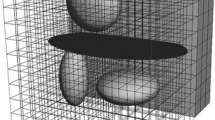Abstract
Cracks and their propagation with a given kinematic velocity are described as zero-level sets of a non-negative scalar function satisfying a transport equation. For smooth velocities this description is equivalent to a crack parameterization where the moving crack is obtained as the image of an initial reference crack under a coordinate transformation. Based on the implicit formulation, bifurcation type phenomena such as branching and merging of the crack, which cannot occur in the parameterized situation, are investigated numerically. Analytical and computational examples of the crack evolution with continuous as well as discontinuous velocities are presented in 2D and 3D domains.
Similar content being viewed by others
References
Adalsteinsson D., Sethian J.A. (1999) The fast construction of extension velocities in level set methods. J. Comput. Phys. 148: 2–22
Ambrosio L., Soner H.M. (1996) Level set approach to mean curvature flow in arbitrary codimension. J. Differ. Geom. 43: 693–737
Ambrosio, L., Soner, H.M.: Flow by mean curvature of surfaces of any codimension. In: Variational Methods for Discontinuous Structures, Progr. Nonlinear Differential Equations Appl., vol. 25, pp. 123–134. Birkhäuser, Basel (1996)
Burchard P., Cheng L.-T., Merriman B., Osher S. (2001) Motion of curves in three spatial dimensions using a level set approach. J. Comput. Phys. 170: 720–741
Burger M. (2001) A level set method for inverse problems. Inverse Probl. 47(5): 1327–1355
Burger, M., Ring, W.: Foundation of a level-set based shape sensitivity analysis (in preparation)
Conway E.D. (1967) Generalized solutions of linear differential equations with discontinuous coefficients and the uniqueness question for multidimensional quasilinear conservation laws. J. Math. Anal. Appl. 18: 238–251
Crandall M.G., Lions P.L. (1986) On existence and uniqueness of solutions of Hamilton–Jacobi equations. Nonlinear Anal. T M A 10: 353–370
Delfour M.C., Zolesio J.-P. (2001) Shapes and Geometries. SIAM, Philadelphia
DiPerna P.J., Lions P.L. (1989) Ordinary differential equations, transport theory and Sobolev spaces. Invent. Math. 98: 511–547
Filippov, A.F.: Differential equations with discontinuous right-hand side. In: Amer. Math. Soc. Transl. Ser. 2, vol. 42, pp. 199–231. AMS, Providence (1964)
Friedman A., Liu Y. (1996) Propagation of cracks in elastic media. Arch. Rat. Mech. Anal. 136(3): 235–290
Hintermüller M., Ring W. (2003) A second order shape optimization approach for image segmentation. SIAM J. Appl. Math. 64(2): 442–467
Ito K., Kunisch K., Li Z. (2001) Level-set function approach to an inverse interface problem. Inverse Probl. 17(5): 1225–1242
Jiang G.-S., Peng D. (2000) Weighted ENO schemes for Hamilton–Jacobi equations. SIAM J. Sci. Comput. 21(6): 2126–2143
Khludnev A.M., Kovtunenko V.A. (2000) Analysis of Cracks in Solids. WIT-Press, Southampton
Khludnev A.M., Ohtsuka K., Sokolowski J. (2002) On derivative of energy functional for elastic bodies with cracks and unilateral conditions. Quart. Appl. Math. 60(1): 99–109
Khludnev A.M., Sokolowski J. (1997) Modelling and Control in Solid Mechanics. Birkhäuser, Basel, Boston
Kovtunenko V.A. (2002) Sensitivity of interfacial cracks to non-linear crack front perturbations. J. Appl. Math. Mech. (ZAMM) 82(6): 387–398
Lions, P.L.: Generalized Solutions of Hamilton–Jacobi Equations. Research Notes Math, vol. 69. Pitman, Boston (1982)
Litman A., Lesselier D., Santosa F. (1998) Reconstruction of a two-dimensional binary obstacle by controlled evolution of a level-set. Inverse Probl. 14: 685–706
Osher, S., Fedkiw R.: Level Set Methods and Dynamic Implicit Surfaces. Applied Mathematical Sciences, vol. 153. Springer, New York (2003)
Osher S., Sethian J. (1988) Fronts propagating with curvature dependent speed: Algorithms based on Hamilton–Jacobi formulations. J. Comput. Phys. 79: 12–49
Osher S., Shu C.-W. (1991) High-order essentially nonoscillatory schemes for Hamilton–Jacobi equations. SIAM J. Numer. Anal. 28(4): 907–922
Petrova G., Popov B. (2001) Linear transport equations with μ-monotone coefficients. J. Math. Anal. Appl. 260: 307–324
Poupaud F., Rascle M. (1997) Measure solutions to the linear multi-dimensional transport equation with non-smooth coefficients. Commun. P.D.Es 22: 337–358
Rice J.R. (1985) First-order variation in elastic fields due to variation in location of a planar crack front. J. Appl. Mech. 52: 571–579
Sethian J.A. (1996) Level Set Methods: Evolving Interfaces in Geometry, Fluid Mechanics, Computer Vision, and Material Science. Cambridge University Press, Cambridge
Sethian J.A. (1996) A fast marching method for monotonically advancing fronts. Proc. Nat. Acad. Sci. 93: 1591–1595
Sokolowski J., Zolesio J.-P. (1992) Introduction to Shape Optimization. Shape Sensitivity Analysis. Springer, Berlin
Stolarska M., Chopp D.L. (2003) Modelling thermal fatigue cracking in integrated circuits by level sets and the extended finite element method. Int. J. Eng. Sci. 41: 2381–2410
Sukumar N., Moës N., Moran B., Belytschko T. (2000) Extended finite element method for three-dimensional crack modelling. Int. J. Numer. Meth. Eng. 48: 1549–1570
Tsitsiklis J.N. (1995) Efficient algorithms for globally optimal trajectories. IEEE Trans. Automat. Control 40: 1528–1538
Ventura G., Xu J.X., Belytschko T. (2002) A vector level set method and new discontinuity approximations for crack growth by EFG. Int. J. Numer. Meth. Eng. 54: 923–944
Author information
Authors and Affiliations
Corresponding author
Additional information
Communicated by G. Wittum.
Rights and permissions
About this article
Cite this article
Kovtunenko, V.A., Kunisch, K. & Ring, W. Propagation and bifurcation of cracks based on implicit surfaces and discontinuous velocities. Comput. Visual Sci. 12, 397–408 (2009). https://doi.org/10.1007/s00791-008-0125-x
Received:
Accepted:
Published:
Issue Date:
DOI: https://doi.org/10.1007/s00791-008-0125-x



